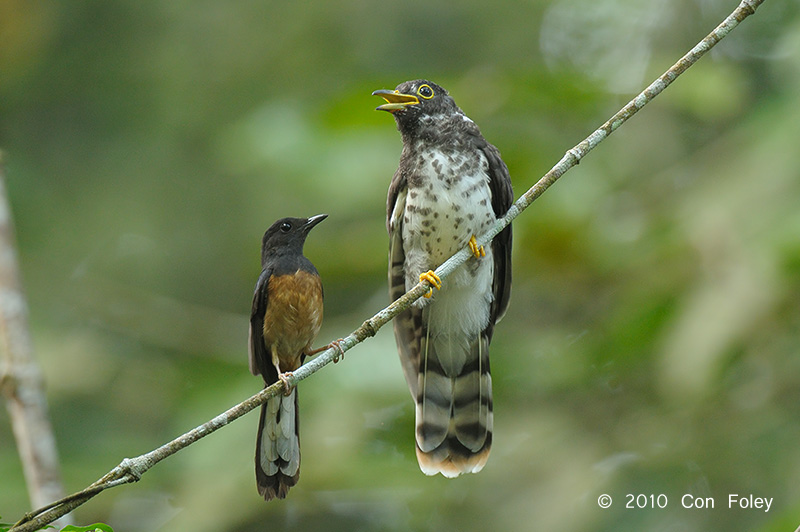On the first day of July, 2010, I was on Bunker Trail, when just before 8:00am I noticed a bird fly from tree to tree that gave me the overall impression of a large cuckoo. I was in the car at the time and so I drove to the forest edge and observed, the bird continued to move from branch to branch until to my great fortune it settled on a relatively open perch. It would stay on this perch for an incredible twenty minutes giving me plenty of time to observe it’s behaviour. One of the first things I noticed was the bird was making a very soft call, and then within a few minutes a female White-rumped Shama flew in. As soon as the female was there, the cuckoo started quivering it’s wings.
Within moments it got feed. The call is vaguely reminiscent of a Rufous-tailed Shama, a single note, sometimes ascending, sometimes descending, but much softer and more coarse. I would later hear the female White-rumped Shama also make a similar soft single note call, cleaner not as coarse as the cuckoo, nor as frequent. Who is imitating whom I am not sure. You can hear the call at a link provided at the end of this article. The juvenile repeated the call at one to two second intervals continuously. Within twenty minutes the female shama flew in twice with food. And then, the juvenile cuckoo successfully foraged for a small caterpillar and flew off to another tree.
At this point I had to get out of the car and I tracked the cuckoo into the forest. This was easy to do by listening to its continual call. I was able to get close enough to obtain satisfactory sound recordings, but no further photos as it was high and obscured. I witnessed the male shama fly up to its perch, but whether with food or not I couldn’t see. I stayed with the cuckoo for another forty minutes until it flew across the road and deeper into the forest.
I returned to Bunker Trail six days later and was very interested to hear the juvenile cuckoo still calling at the same location before 8:00am. As the call was inside the forest I had to bash in and I was able to work my way close enough to see the female shama fly to the perch beside the cuckoo and feed him. Satisfied that all was well I left the family assuming the juvenile cuckoo will become independent shortly.
Panti is filled with cuckoos, and I’ve seen one other host feeding a juvenile cuckoo, last year, the Chestnut-winged Babbler feeding an Asian Drongo Cuckoo. Perhaps cuckoos are so secretive because they must know their territory intimately and know when to lay their egg. White-rumped Shamas generally make their nest in the open top of a broken tree stump, where they would be easy to parasitize. Infrequently they will make their nest in an old woodpecker hole, and I should think this type of nest would be safe.
References:
Video and sound of Juvenile Mayalsian Hawk Cuckoo at Vimeo.
David R Wells: The Birds of the Thai-Malay Peninsula, Vol 2, pp 508-513 & Vol 1, pp 376-378
Notes:
Later in the same year, another juvenile Malaysian Hawk Cuckoo was being feed by Shamas at a location near to the entrance of Bunker Trail. This year, 2011, I had the good fortune to see a juvenile White-rumped Shama being feed by it’s true parents. Interestingly, the juvenile shama begging-for-food call was very similar to that of the juvenile Malaysian Hawk Cuckoo, leading me to think that the cuckoo has learned to imitate the call of it’s host.
A version of this article appeared in Nature Watch (a publication of Nature Society Singapore) in the Volume 18 No 3 Jul-Sep 2010 issue.
Tags: birds, Malaysia, Nature Watch




I thank you for uploading such a good documentation of parasitism in cuckoos. It helped me clarifying my understanding of an experience that resembles much to yours. I could not at first point out that it was a case of parasitism. Thank you.
I have uploaded a photo frame of similar incidence @ the link
https://www.facebook.com/groups/indianbirds/10151500274452411/?notif_t=like
please visit.
Anindya Bhattacharya
Brilliant documentation. I’m always amazed at this behavior.